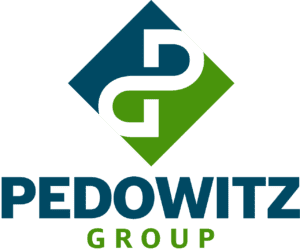Have you ever wondered how you (or your team) got this to this point?
Content everywhere… your team (or you, if you’re the content marketer) keeps talking about how much of it is bad. Some is probably outdated, others were blogs you “had” to publish, and providing an outstanding experience for visitors is more difficult. Heck, you can name 5-10 blogs on your site off the cuff you wouldn’t dare advertise.
Enter: An SEO content audit.
I’m going to take you through how I did ours, and some of the lessons learned along the way. I wasn’t looking to create a content bloodbath, but it quickly became one as I found dozens of ways to improve what we offer our customers and prospects.
This endeavor was well worth it.
In six months, we saw:
- 30% increase in marketing-sourced pipeline
- 25% increase in net-new leads in key strategic areas, primarily from organic traffic
- > 2x spike in organic search ranks showing in the top 3 of Google (which is where a majority of clicks occur) that’s held steady despite multiple algorithm updates since completion
Even better? It setup future SEO work for greater success! We had our best year ever for marketing-sourced revenue the following year, with over 2x marketing-sourced revenue from our website from previous years and hit 120% of our marketing-sourced number… and 70%+ of those leads were generated organically.
We’ve also seen that nearly every lead that comes into our database with 1-2 organic touchpoints and our Sales team has had an increase in leads that came in organically – but none of it would’ve been possible without going through this exercise.
So, ready to start building towards results for you?
Note: Open up this worksheet, and keep it handy as a guide to follow on as you read.
Click to jump to a section:
The Business Case | Step 1: Get A List | Step 2: Check Traffic | Step 3: Check Backlinks | Step 4: GSC
Step 5: Avoid A Stupid Mistake | Step 6: Make Decisions | Measure Results | Next Steps
The Business Case For A Content Audit
If you’re considering investing in this area, here’s where to begin:
What’s The Problem You’re Solving?
There are three:
- Eliminating bad / wasteful content on your site that hurts your search engine optimization (SEO)
- Ensure any content your team uses (and a prospect or customer can find) is high-quality and builds trust with your target audience.
- Identify content gaps in your customer’s buying journey
Consider this: 67% of customers say their standard for good experiences is higher than they’ve ever been (Salesforce) and the leading reason why customers have limited engagement with B2B companies is because marketers are sending them too much irrelevant content. (KoMarketing)
Every digital touchpoint needs to be on-point for a customer experience that exceeds expectations… and it starts with your content marketing efforts.
What Do You Gain From This?
In true revenue marketing form … we absolutely can draw a bottom-line impact.
Take your funnel from only organic traffic. Conversions, SQLs, and closed-won revenue. What would a 3% increase in traffic do for the revenue number? A 5% increase?
If you have a way to identify how many pieces of content the average closed-won deal interacts with, this only supplements your case as higher-quality content = more likely to build trust and get sales more calls.
At a more tactical level, you’re still solving for those three problems outlined above. Let’s explore each:
Improve SEO
Google (and Bing, and DuckDuckGo, etc.) really focuses on one word in everything it does: Relevancy.
If your content is authoritative, builds trust with a reader, and answers what a person is looking for (and goes above-and-beyond in doing so), you’ll stand a much greater chance of ranking well.
But the opposite is also true! If you have low-quality content across your site (or just as bad, different content that basically talks about the same thing), it’ll actually hurt your overall SEO.
A term for this is “index bloat.” Essentially, Google’s index of your site contains a bunch of poor content that doesn’t help people get what they’re looking for.
Google is always gauging what your site’s about and determining how relevant you are to a given topic / query, so you want anything it sees to be high-quality. While your audit isn’t only about SEO, it absolutely has massive implications for SEO (which can, in turn, impact other areas, such as your in-market campaigns).
User experience
Have you ever read something on a website that made you say “Wow, these people know what they’re talking about” almost immediately?
That’s what your content should do. But does it?
Every digital touchpoint a prospect / customer has with your content either builds their confidence in you, or creates a missed opportunity. Each asset you have should have a clear, defined purpose as to why it exists – and it shouldn’t compete with other assets.
Related: Examining the ungated vs. gated content debate
Identify gaps
Let’s say I’m shopping for shoes, but I’m currently researching shoe types, available options, etc. You have a great article that walks through 25 must-knows (in great detail) about nailing your next shoe purchase, and I see it ranking high in Google and click on it.
What do you want me to read next?
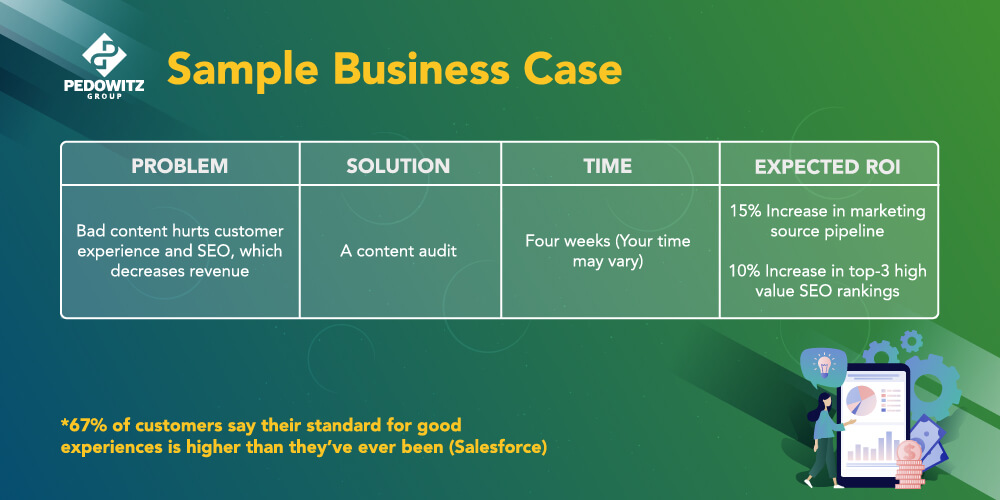
I’m not going to purchase just because you had one good article. It could take just a handful, or far more depending on what I’m researching. Even in the B2B space, there’s been research from as far back as 2013 showing the importance of every interaction working together.
As you chart how your content works in cohesion, you’ll find places where something is missing. This is great! Now you know what to create next – and how you’ll implement in your go-to-market strategies.
What’s The Investment?
Here’s some good news: You shouldn’t need a new tool, unless your team currently doesn’t have an SEO tool it works with now. This may be a great jump point to help build that business case for one. Ahrefs, Majestic, and SEMrush are three leaders in the space, though they aren’t the only good options.
If you have a tool already, the monetary cost should be zero.
However, you’ll need to do some serious blocking-and-tackling for your team to do this right because of the necessary time investment.
It took me over a month to go through our entire site, and this was while juggling everything else I’m responsible for. Depending on the size of your website and number of assets, you may need more or less, but your team needs your support so they can put in the requisite time.
Can We Automate This?
No.
Don’t get me wrong, I love automation. But an audit demands someone puts eyes on every piece to determine if it’s good or not. “Good” is subjective!
Here’s two common outcomes that you can only attain through actually looking over the content:
- Something that’s five years old and doesn’t rank within your SEO data seems like it’s prime for deletion, until you read it and realize there’s good ideas / writing that should be used elsewhere.
- A blog that ranks well needs an overhaul due to outdated information or updates to your service offering
Data alone can’t tell the entire story.
You must combine objective data with your subjective views to make the most informed decision. After all, marketing is part science, part art!
What’s The Opportunity Cost If We Don’t Do This?
Among U.S. customers, 65% find a positive experience with a brand to be more influential than great advertising. (PwC)
- If you don’t increase your organic traffic … how will your marketing pipeline suffer?
- If you run multi-channel campaigns, can you afford to advertise content that isn’t impressing the reader?
So … are you ready to dive into our content audit and see how we enhanced all of our content marketing, SEO, and account-based marketing without being insanely technical? It begins with:
Step 1: Get a list of content
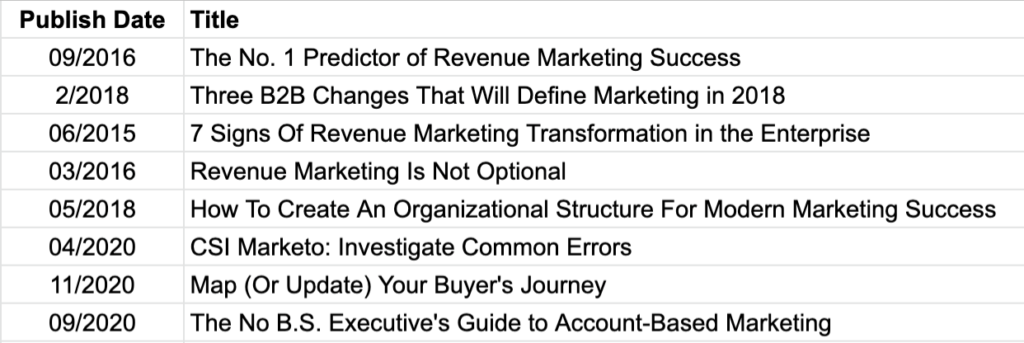
An easy way to build this list is to extract it from your site. We use WordPress, so I exported the full list (here are two methods, from ElegantTheme).
You could also crawl your site using a tool like ScreamingFrog.
Add the following columns into a spreadsheet:
- What To Do?
- Traffic
- Engagement
- Backlinks
- GSC indication (for Google Search Console)
- Currently in any campaign?
Now, copy / paste your full list of content next to these columns. It should look something like this.
Your goal is to use each piece of information to determine what to do with each asset. If you’re the type who prefers a good picklist, in the “What To Do?” and “What Does GSC indicate?” columns, your options should be Combine, Delete, Optimize, Redirect, or Unclear.
We’ll come back to these options in greater detail in step six.
Note: You’ll notice there is no option for “Good as-is” … even your best content published last week can be improved with another pass-through or small upgrade, so it’d fall into the Optimize category. You might put more recent content towards the bottom of the to-do list, though.
Step 2: Investigate Traffic / Engagement
Using your analytics platform, it’s time to look into each piece of content’s data over the past 12 months. This should give you a healthy sample size to make informed decisions.
For us, that’s Google Analytics. I looked at unique pageviews for each asset and input that into the spreadsheet in the Traffic column. For this exercise, it’s a good data point that takes very little effort to attain.

Engagement
Your expertise, business goals, and customer journey maturity all inform your decision here.
Some great data points to focus on:
- Conversion value – How much expected revenue contribution to your pipeline does a given action (form fill-out, assessment taken, etc.) add?
- Conversion rates – What is the rate of people who viewed content vs. how many became a lead?
- Pages / session – Best when used in the Landing Pages report in your Analytics … what content makes users want to spend more time on your site?
Look at each of the three and ask yourself if the page has users doing what you’d hope they do. Is this content early-stage for research (pages/session), or late-stage with buying intent (conversion rate)?
Engagement is either low, medium, or high, and you’ll have to determine what fits into each category.
Use your instincts and baseline it with your data. I used the following for ours, leveraging the past two years of Analytics data as a guide:
- Conversion rate < 1% (Using Landing Pages report) or Pages / Session < 1.5 = Low
- Conversion rate < 2% or Pages / Session < 2.5 = Medium
- Conversion rate > 2% or Pages / Session > 2.5 = High
Step 3: Backlinks
Even if a page has low traffic / engagement, it could still have value – and backlinks are one way to discover this.
A backlink is any link from another site that points to yours. Not all links are created equal, though – a link from a site with a strong reputation on topics related to what you do is worth far more than a random blog’s link, for example.
Using a tool like Ahrefs, Majestic, or SEMrush, identify how many external backlinks are pointing to a given page. List that number in the column in your spreadsheet.
Note: Each link above goes to a free tool, but a trial / paid version is recommended as you likely examine dozens (or hundreds) of assets. If you don’t have one in your tech stack, it is absolutely worth investigating.
Bonus
If you have access to more in-depth backlinking data and love SEO, a quick glance is well worth the time. Add a column in your audit document for “backlink quality” and use a bad / mediocre / good system of ranking for an extra data point.
Here’s a few things to consider:
- Link quality. Are there links from other websites in your particular niche? Is the rate of toxic links (those from very low-quality sites) high?
- Gut check your “best” link. Visit the page! Is it reputable content that adds value to a user?
- Glance at your tool’s metrics. Each one has a proprietary metric, such as “Trust Flow” or “Domain Rank” to give a quick sense of how good a backlink can be.
Remember: You need a scalable process for the entirety of your audit. It’s easy to develop tunnel vision looking at backlink data, but we only need enough to get a sense of how a given asset is regarded in the digital ecosphere.
Step 4: Google Search Console
This is my favorite step of this process, because there’s a degree of data reliance that requires your instincts to make it usable.
Your goal is this: What is your Google Search Console (GSC) data telling you? This is the best source of data you can have, because you’ll see clicks, impressions, what queries a given page is showing for, and where it ranks … directly from Google!
If you’re unfamiliar with GSC, here is a great guide to using all of it. For our content audit, I’m only focusing on one set of data, so even if you’re brand-new to Search Console you’ll be just fine.
Note: You will need to have access to your company’s Google Search Console to do this. Don’t have it? Ask whomever is in charge (often someone dedicated to SEO or the website) to grant it to you. Here’s more on this topic from Google Webmaster.
Open Google Sheets and Grab An Add-On
In the menu, click Add-Ons > Get Add-Ons to open Google’s Marketplace. Search for “Search Analytics For Sheets.”

There’s a few great options that appear, but I’ve found the original “Search Analytics for Sheets” to be perfect for this exercise. It’s easy to use and does the one thing I need it to do for a good SEO analysis of my content: get my data into Google Sheets from Search Console.
Once installed, open the sidebar and:
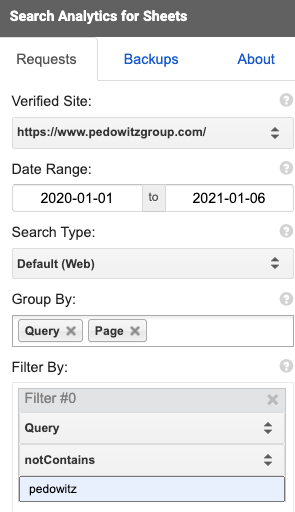
- Select the past 12 months as the date range
- Leave search type as Web
- For the Group By section, choose Query and Page. If you’re a global organization, Country could also be something worth adding here, but it may also unnecessarily segment your data into something more complex.
- For filters, remove your brand name with the “notContains” option. You don’t want branded searches skewing your data! If you’re curious how it can be used, Search Engine Watch has a good article.
- If your business operates in a single country, add a filter for Country and input where you operate. Google uses country abbreviations, so I would input “usa” for this field if I wanted data from users in the United States.
If you’re a global organization, you may want to filter out a particular country if it’s been known to skew your data.
Select if you want a new sheet or the current sheet for your data, and click the “Request data” button. Now you have a sheet filled with SEO data to mine!
Your goal here is to determine what Google’s data is telling you to do.
Use the filter on the column that has the list of pages, and search for each piece of content by its URL. Here’s what you’re looking for:
What terms does this content rank for? You may find some content that shows for queries that have nothing to do with your business.
Where does it rank for those terms? The average position gives you an immediate idea of its viability. Is it in the top 30? Then perhaps there’s potential. Top 10? You’re looking at an opportunity to improve it and get closer to the top 3, which is where most clicks happen.
Do the terms it’s ranking for have search volume? This is not that important, as content can be high-value even if it only shows five times in a given month. But this can give you a sense on how often your content even shows in Google’s results … and how often people are searching for those terms.
Are multiple pieces of content ranking for the same terms? You may see a trend where some do. In this case, filter by query and see what pages Google is showing.
Typically, this means you have keyword cannibalization … in short, your content’s fighting itself for what’s most relevant! This is a prime opportunity to find chances to combine related pieces of content into something far more harmonious.
Now, open the content in a new tab.
Have you noticed we’re halfway through step four, and I haven’t asked you to look at anything but data so far? That’s intentional!
The data you’ve looked at so far provides a solid framework for evaluation and can combat particular biases you may have about a certain piece. For example, if you know a blog the CEO wrote six months ago is doing nothing according to your traffic, backlinking, and GSC data, you’re far more likely to recommend deleting it than you might otherwise!
This is where art meets science. If a user types in that given term, will they be happy they took time to read this article, infographic, or eBook… or will they be left wanting?
Now is the time to loop in that impression. As you read the terms a given page ranks for, give it a quick read and marry the data with your instinct.
Here’s an actual example from some of our data from a while ago:

Right away, I see content competing with each other for the term revenue marketing. That tells me Google isn’t sure which content is most relevant to a user searching for “revenue marketing.”
This isn’t good!
Now, let’s look at the same list, but with the rest of the data:

Here’s what I determined GSC was telling me:
- Optimize: Revenue Marketing Journey. It ranks one page one for multiple terms + is getting traffic, and the post itself was helpful to the reader.
- Combine: 3 C’s of revenue marketing culture. Yes, it ranks, but it’s competing for the same core term as others and on its own is only a concept that needs more to be taken through to application.
- Combine: 7 Signs Of Revenue Marketing Transformation. Good content, but it’s not ranking well on its own.
- Delete: B2B and Consumer Marketing Strategies. Few impressions, poor rank, and if I filter in the “Page” column for just that content, there’s no other data telling me to do otherwise.
- Delete: B2B Marketing Changes That Will Define 2018. Outdated, not really ranking for anything on its own.
If one of the listed blogs was ranking for a handful of terms, but its average position for each was somewhere in the 20-40 range, that’d be a prime candidate for a redirect.
Note: It’s helpful to have the same set of data in two tabs. On one, input a filter on the Query column, and in the second tab, have the Filter on the Page column. This way, you can quickly toggle between the two and look at the data on both the keyword and the page level.
I relied heavily on the Page filtering to get a sense of how each blog on our site was doing, but the additional context from Query helped identify how unique each blog truly was – or what it was competing with.
Should you delete, optimize, redirect, or combine content with others to make it stronger?
Based on what you see in your data, input your determination into the “What does GSC indicate?” column in the worksheet.
I don’t believe you should have an “Unclear” option for this step. You aren’t committing to an action yet, so don’t be afraid to stick with your instinct. When in doubt, look to re-use the content elsewhere so you don’t end up deleting something potentially useful to your reader.
Step 5: Make Sure You Don’t Delete Something That’s In-Market Now

Yep, I totally did this by accident.
I actually walked through the entire “Delete” list with two other team members before beginning to delete any of it, but it turns out two pieces were in nurture campaigns that all of us overlooked!
So aside from wanting to pull a Homer Simpson for a brief moment, the lessons here are two-fold:
First, check active campaigns in all fronts to know what content you’re marketing and mark those you are in your spreadsheet. This prevents you from outright deleting the content without also adjusting your campaign(s), but you can absolutely optimize or combine / redirect this content to something else and prevent a poor user experience.
Second, have a backup of anything you delete just in case you need it! Any site platform has a way to do this. In our case, we have a sandbox with a backup of the site on a separate server, so it was a simple task to copy / paste those blogs back onto our main site.
Step 6: Make Decisions
Now you have your four main pieces of data, plus you’ve put eyes on it all. It’s time to decide what to do with your content!
Here’s your options:
Combine – Used for related assets that a user would appreciate having all in one place. Doesn’t have to have had backlinks, traffic, etc. if it’s good and worth using.
Delete – Simply put, flat-out delete the content. No redirect needed, because it doesn’t have enough backlinks or authority to warrant it.
Optimize – Keep content as-is, but see if you can enhance it. This could be as simple as embedding a related video, or incorporating new, updated content to keep it fresh.
Redirect – For content that has some staying power (backlinks, relevancy per Google Search Console) but not enough to warrant keeping on its own. Content potentially can be repurposed elsewhere. Also could be used for content competing with other assets on your site for a query.
Unclear – For when you just aren’t sure. When in doubt, don’t delete … either optimize or combine into something else, then revisit in 3-6 months in Google Search Console to see its impact.
Note: When you actually do use content elsewhere, make sure to enable a redirect to its new location!
How I ended up deleting half our site… and what to know
For years, content was produced for a variety of reasons, most of which you likely can relate to:
- Support key events
- Blogs being a part of a staff’s bonus requirements
- Leaders writing on what they’re seeing in the market
- 5-part blog series, published in order of when the blogs were received
- Gated assets pulled together because of proprietary research needing to be taken to market
The list could go on, but over time this adds up to a lot of content … and a lot of “delete” candidates. In the first iteration, I deleted 280+ content pieces from our website in summer of 2020. As I began working though blogs on the “Combine” list, I realized there was some duplication, which led to even more deletions.
All told, in a six-month span I ended up deleting over 320 pieces of content, primarily consisting of blogs and old landing pages – but also some gated assets, infographics, etc.
It takes time to make “good” happen
I also combined a lot of other content into something that would be far more likely to capture a reader’s attention. Do you remember the example earlier where we had multiple blogs showing in Google’s index for the phrase “revenue marketing?”
Now we have only one ranking for the term: Our blog titled “What is revenue marketing? The key to earning a seat at the revenue table.”
To build it, I pulled from blogs we had on the topic + ideas and graphics found in internal PDFs, presentations, etc. and built it out. It took three rounds of edits spaced over two weeks to come together.
Two weeks for one authoritative blog!
An audit is a time commitment on its own, but then you need even more commitment to act upon what you find and create content that impresses your readers.
Months later, I’m still leaning on this audit’s findings
As we create new content, I may see other content on that same topic… now’s the perfect time to quickly audit what we have and see how it all ties together.
One example: Months after I’d finished this original project, we worked on what is now a marketing automation executive’s guide, and I discovered three blogs we’d written that had some great information but overlapped. So, I pulled the relevant content into the guide, then deleted two of them and redirected a third (the only one that had backlinks / link equity to pass on).
This isn’t a one-and-done project, as your content marketing needs to have this a piece of all future developments as well!
Wait, how do we measure the results of all this work?
Make no mistake: Because this requires a significant time commitment, any leader will want to know what the return on this investment is.
Here’s four ways to show ROI:
Organic traffic’s impact on pipeline
- As people become leads and eventually get sent to sales, are these people engaging with content I’ve improved? One way I check is from a report in our marketing automation system and looking at a lead’s activity log
- How much pipeline is generated with an original referrer of organic? Has it increased?
Quantifying your content’s impact on revenue is a critical component of evolving from lead generation to robust revenue marketing, after all!
Conversion rates
I have a Google Data Studio report with a page for each area we’ve taken to market, focusing on key metrics and assets we’re actively advertising. This shows a clear path from research-focused content to gated assets and makes it easier to pinpoint what is/isn’t providing value to the reader.
If you’ve strengthened existing blogs and removed poor ones, people should decide you’re more worth their time and your conversions should increase!
Rank improvements
Are we ranking for more relevant terms to what we offer, and are our current rankings improving?
This is an operational metric and should not be a KPI. However, this presents a great way to showcase your progress: Any person, marketing or not, understands “we rank front-and-center for [insert core phrase] on Google” is something worth celebrating!
I track this on a monthly basis. I enjoy digging into the Search Console data and pulling it into an Excel spreadsheet for some analysis month-over-month and year-over-year. There’s many ways you can slice the data, but an easy starting point can be regularly totaling your top 3, top 5, top 10, and top 20 ranks and highlighting some key movements on high-value terms.
Remember, it’s not just the amount of rankings, but also what you rank for.
Pages / Session
Not a core key performance indicator (we have a free course on establishing good KPIs, by the way), but in your analytics it can be a solid way to determine if your content is good enough to warrant a person continuing to invest their time with what you have.
My results
Since the initial audit was completed in summer, I compared numbers six months later. I prefer year-over-year (YoY) metrics to try and eliminate seasonal impacts, but it can be useful to look at both YoY and quarter-over-quarter (QoQ).
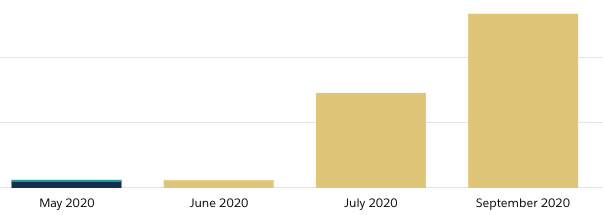
- Marketing pipeline: Up 30% QoQ, down YoY (believed to be due to COVID impacts on target markets)
- Conversion rate: Up 67% QoQ and 17% YoY
- Organic traffic: Up 17% QoQ, up 5% YoY
- Top 3 rankings: Up 16% QoQ, but after six months had a 116% increase
- Pages / Session: Up 32% (looking at stats on landing page I’d improved or newly-created vs. previous content)
From our CRM dashboard, this is what our closed-won marketing-sourced revenue graph shows:
Here’s a glimpse into our Google Search Console, where blue is clicks and purple is impressions:

While I can’t reveal exact numbers for competitive reasons, the numbers are in the thousands for site traffic.
A few things to highlight:
Organic traffic initially dipped
I can hear it now: “Hang on … your organic traffic went down and I’m supposed to believe this is a good idea?”
Yes! For two reasons:
- Traffic is a vanity metric, much like Facebook page likes. It doesn’t mean much on its own.
- You should have less traffic after you delete a bunch of bad content. But that means the quality of your remaining traffic should be higher.
If organic traffic can’t be tied to revenue, it’s worthless as any sort of key performance indicator. Make sure to use a combination of traffic, conversion rates, and the % of leads that become sales-qualified. From there, you should be able to use your deal win rate, and tie the math together to show how a bump in organic traffic can lead to higher pipeline.
Also … note my conversion rates improved!
My rankings also initially dipped
Quantitatively, I got spooked when I saw the dip: a 37% decrease in top-3 ranks. “Oh crap, was this a good idea?”
Then, I dug into the data and noticed that what we’d been previously ranking for wasn’t going to drive revenue. Terms like “lead stages”, “benefits of social media for individuals”, and “investing in marketing” had disappeared.
Those weren’t going to drive the people in my ideal customer profile anyway!
Sure enough, after a few months, we had a spike in top-3 and top-5 rankings, and many had much stronger buying intent (think something like “marketing consultant” which is what we do).
It took time to see the results
Deleting a bunch of content at once? Easy.
Combining other pieces of content into authoritative reads for a given topic? That took longer, but you can see the results as we’ve rolled out more of this. I’d say it was roughly three months before things began taking a noticeable tick upwards.
It also seems we got a positive bump from the first Google core update that hit after I’d done much of the heavy lifting (in Dec. 2020), which is always a positive sign.
In fact, about 7-8 months later, other work built on top of these efforts and we’ve seen more booked calls coming in from people who have found some of our services pages organically. Those pages rank in the top 3 in Google, when previously they might’ve been lucky to be seen on page three!
Next Steps
I’m always happy to talk on LinkedIn if you have any questions! You may also find these helpful:
- Want help with your marketing? See how our digital advertising consulting can help you!
- Map / Update your buyer’s journey for a better idea of how to organize your content to a person’s buying stage
- If you’re considering Account-Based Marketing, you’ll need this audit to ensure you provide the right messages for each buying stage. Head over to this executive’s guide to dive in.
Want more marketing content on a variety of topics? Head to our resources hub!
